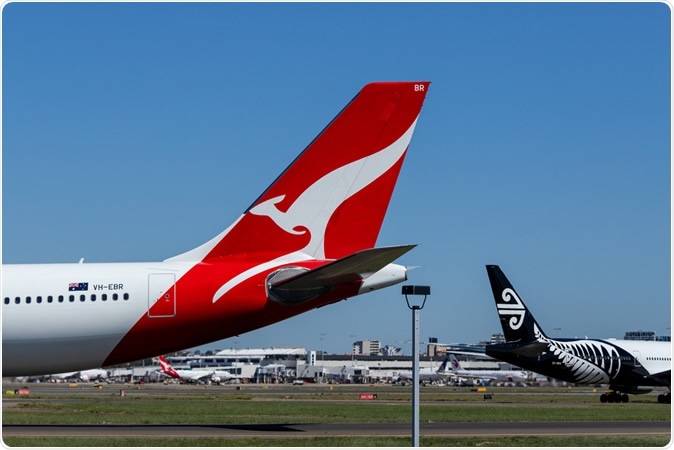The coronavirus pandemic that has rippled across the globe has linked Australia and New Zealand closer, as two leaders issued a joint statement that would pursue a trans-Tasman COVID-free travel zone once both countries had lifted restrictions.
With the new travel bubble, travelers could fly between Australia and New Zealand without undergoing the mandatory 14-day quarantine at either end of the journey. The new link is now being discussed by the two leaders, New Zealand Prime Minister Jacinda Ardern, and Australia’s Prime Minister Scott Morrison.

Qantas and Air New Zealand aircraft. Image Credit: aiyoshi597 / Shutterstock
The ongoing discussions will help prioritize flights across the Tasman before Australia, and New Zealand lift restrictions on international travel.
NZ PM says trans-Tasman travel bubble would deliver 'huge advantages' to Australia | ABC News
What is the trans-Tasman travel bubble?
The trans-Tasman travel bubble involves establishing an exclusive travel zone, opening the borders between two countries. It was initially an agreement between the two countries in 1973, allowing for the free movement of citizens between these two countries. The arrangement also allows residents of each country to reside and work in the other, with some restrictions.
The arrangement will be modified amid the coronavirus pandemic. Typically, traveling to another country today may have a “new normal,” with travelers having to spend 14 days in quarantine once they arrive in their destinations. However, in the trans-Tasman travel bubble, residents of both countries will not need to self-quarantine once they arrive.
Huge advantages for both countries
New Zealand’s Prime Minister has announced that the travel bubble would offer massive benefits to both countries, as they intensify negotiations over potentially opening borders later this year.
The coronavirus pandemic has not taken a heavy toll on either country in terms of infections and fatalities when compared with others. Both countries have gained international praise for effectively containing the spread of the virus by successfully ‘flattening the curve.’
Since the coronavirus has negatively impacted both countries, opening international flights over the Tasman could aid in kickstarting their economies. The countries are scheduled to discuss the proposal in the Australian Government’s National cabinet meeting.
“There are significant advantages to New Zealand in terms of a trans-Tasman bubble not only [in terms of] domestic tourism, but equally we have a flow of people traveling between both countries, for business purposes, trade and so on. So, it is to our advantage, but equally, Prime Minister Morrison has articulated a huge advantage for Australia,” Prime Minister Arden said.
The key to a successful travel arrangement between the two countries will be sturdy and sound planning and implementation. They should impose comprehensive public health measures to facilitate safe travel, including preparing for all travel to be stopped again if the situation calls for it.
However, both leaders have cautioned that a ‘travel bubble’ will not commence immediately. The safe travel zone is still some time away, but it is essential to negotiate now amid the coronavirus pandemic. Both countries are still fighting the pandemic and have reported reduced cases over the past weeks.
Successful COVID-19 fight
Australia and New Zealand have gained immense praise from the international community as they had successfully flattened the curve of infections. Australia has reported 6,849 cases and 96 deaths, while New Zealand has only 1,488 cases and 21 deaths.

Australia daily new cases of COVID-19. Image Credit: COVID-19 Dashboard by the Center for Systems Science and Engineering (CSSE) at Johns Hopkins University (JHU)

New Zealand daily new cases of COVID-19. Image Credit: COVID-19 Dashboard by the Center for Systems Science and Engineering (CSSE) at Johns Hopkins University (JHU)
Health experts say Australia and New Zealand’s low case rates are good examples of how to combat the coronavirus pandemic successfully. Both countries have worked hard to contain the virus spread, and have now eased restrictions while developing new normal measures to reduce future transmission.
For instance, New Zealand has avoided a widespread transmission of the virus. It has now lifted strict social measures, while Australia has eased some restrictions. Social distancing measures are still in place in the country, while citizens are downloading the government’s voluntary coronavirus tracking app, which notifies if someone they know has contracted the virus.
Both countries were successful in imposing early lockdown measures, restricting international travels, and providing widespread testing capacities. Further, the key to their success is public adherence to the rules. Despite the success, the countries are not being complacent in lifting restrictions, as they impose new rules that residents should follow to prevent the transmission of the virus. Overall, social distancing measures are still in place while they will conduct mass testing to isolate infected individuals efficiently.